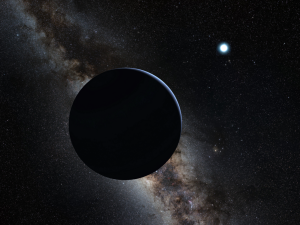
Ever since astronomers Konstantin Batygin and Michael Brown hypothesized in 2016 that an undiscovered planet hidden in the far reaches of the solar system was responsible for the odd orbits of the dwarf planets that lurk there, astrophysicists have searched in vain for this enigmatic ninth planet. But other theories have also been put forward to explain the seemingly-disturbed orbits of far-flung bodies such as Sedna, including a previously-proposed modification of Newton’s law of gravity that seems to fit the outer solar system’s orbital dynamics surprisingly well.
First proposed as an explanation as to why stars closer to the edge of their home galaxies move faster than what our current understanding of physics would predict, modified Newtonian dynamics (MOND) suggests that Newton’s law of universal gravitation, as described by Sir Isaac’s 1687 work Principia Mathematica, works well until the accelerations experienced by the objects involved are extremely small. MOND is also an alternative explanation for the idea of dark matter, an invisible source of gravity that, if proven to be correct, would make up more than four-fifths of the mass in the universe.
This alternative to the commonly-accepted theory of gravity seems to work well at very large, galactic scales, but physicists Katherine Brown and Harsh Mathur, professors at Hamilton College and Case Western Reserve University, respectively, decided to apply the MOND model to the wayward orbits of trans-Neptunian objects to see if the idea works at small scales as well.
At first, Brown assumed that the predictions made using MOND might differ from what was being observed in the far-flung orbits of the objects that were supposedly altered by the gravitational pull of Planet Nine, due to the drastic change in scale from the galactic-scale motions MOND is usually used to model, hence her and Mathur’s idea to test the hypothesis against their small-scale mechanics.
“We wanted to see if the data that support the Planet Nine hypothesis would effectively rule out MOND,” Brown explained.
However, they found that MOND predicted the elongated orbits of the trans-Neptunian objects quite accurately. “MOND is really good at explaining galactic-scale observations,” Mathur said, “but I hadn’t expected that it would have noticeable effects on the outer solar system.”
Their model discovered that, over the course of millions of years, the collective gravitational field of the galaxy’s mass would drag the orbits of the objects in the outer solar system into the same alignment that they follow today, without the need for a planet six times more massive than the Earth nearby to cast them about. “The alignment was striking,” according to Mathur.
Although Brown and Mathur didn’t set out to disprove the idea of Planet Nine—their motivation was simply to test the viability of MOND at small scales—they feel that this discovery could mean that this alternative to Newton’s fundamental laws of physics could prove useful to further our understanding of the cosmos.
“Regardless of the outcome, this work highlights the potential for the outer solar system to serve as a laboratory for testing gravity and studying fundamental problems of physics,” Brown remarked.
Subscribers, to watch the subscriber version of the video, first log in then click on Dreamland Subscriber-Only Video Podcast link.
Thank you. There are also new findings on gravitational waves:
https://www.npr.org/2023/06/28/1183878163/new-gravitational-wave-supermassive-black-hole